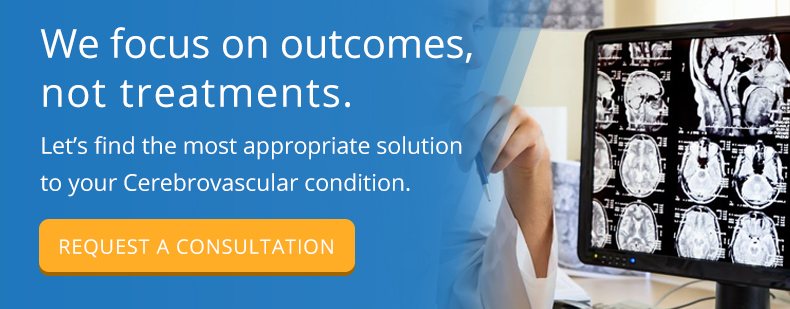A cerebral, or brain, aneurysm is caused by a weak or damaged area in a blood vessel in the brain. Instead of flowing normally, blood collects at the damage, creating a sac that bulges outward into surrounding tissues. In some instances, an aneurysm can enlarge with blood and create pressure, causing symptoms such as headache, vision disturbances or neurological problems.
In most cases, aneurysms grow without causing any symptoms until one day when they leak or rupture, releasing blood into the brain or into the space between the brain and the tissue covering it. This is called a subarachnoid hemorrhage, and it can be a life-threatening medical emergency that needs immediate treatment. People who survived a subarachnoid hemorrhage describe the onset as sudden and as the “worst headache of their lives”.
Brain aneurysm treatment and recovery can vary. Some aneurysms only need to be monitored. In other cases, medications can be used to manage the symptoms caused by the aneurysm.
Your doctors may also recommend a surgical procedure to seal off the aneurysm and prevent a rupture. There are three possible surgical options for resolving an unruptured aneurysm: clipping, coiling and pipeline embolization.
Aneurysm Clipping
Aneurysm clipping is a traditional, open surgery procedure in which surgeons open the skull and brain, and place a metal clip directly across the “neck” of an aneurysm. This closes the aneurysm off from the main artery so that blood can no longer flow into the sac. Eventually, the aneurysm shrinks and disappears.
Clipping can be performed on both ruptured and unruptured aneurysms, even those with very wide necks that are often considered difficult to treat. Because aneurysm clipping is an invasive procedure that requires general anesthesia, it has a longer recovery time than other surgical treatments for aneurysms.
FAQs About Clipping
How long will I be in the hospital?
A typical hospital stay after clipping surgery is between two to five days, without complications. During this time, your care team will monitor your recovery and check for any neurological problems arising from the surgery. If surgery was performed to treat a ruptured aneurysm, your hospital stay may last a week or more.
When can I return to normal activities?
Recovery at home after clipping surgery can take three to six weeks, unless you have special considerations such as other ongoing health conditions. During the first few days, you’ll be told not to drive, lift heavy objects or engage in strenuous activities, but you may be able to return to work or school within three to six weeks, unless your doctor says otherwise.
What are the risks of clipping?
Clipping is an invasive surgical procedure so the usual risks of surgery apply. Clipping also poses risks of stroke, or of neurological problems caused by damage to brain tissue or blood vessels during the surgery.
Aneurysm Coiling
Coiling is a minimally invasive procedure that does not require opening the skull. In this procedure, surgeons access the aneurysm by threading a catheter through an incision in a large artery, usually the femoral artery in the groin. Using contrast dye and X-ray imaging, your doctor uses a microcatheter to insert a series of tiny platinum coils directly into the aneurysm. The coils form a tight ball that seals off the aneurysm and prevents blood from flowing into it.
FAQs About Coiling
How long does coiling take?
The coiling procedure takes between an hour and a half and three hours in the hospital under general anesthesia. Without complications, you can expect to spend a day or two in the hospital. Recovery at home typically takes between one and two weeks.
What are the risks of coiling?
Aneurysm coiling is largely safe, but risks can include bleeding in the brain or stroke, as well as allergic reactions to the contrast dye used in imaging, or to the coils themselves. X-rays are used to visualize the aneurysm and arteries. Radiation dosages are recorded during the procedure.
Will I need more treatment after coiling?
Coiling can resolve an aneurysm completely, but in some cases the coils may compact so that they no longer fill the aneurysm and more need to be added over time.
Pipeline Embolization Procedure
Pipeline embolization is a new and minimally invasive procedure to treat unruptured aneurysms, including ones that were once considered too difficult to treat. Unlike other treatment options, pipeline embolization affects the parent artery, not the aneurysm itself.
Pipeline embolization is an endovascular procedure that involves a catheter inserted through an incision in the femoral artery in the groin. At the aneurysm site, a mesh stent called a Pipeline Embolization Device, or PED, is placed into the artery itself. This device directs blood to flow through the artery, bypassing the aneurysm entirely. Over time, it shrinks and disappears.
FAQs About Pipeline Embolization
How long does the procedure take?
A pipeline embolization usually takes around an hour and a half, although it can take up to three hours or more. Pipeline embolization is typically done in a hospital setting under general anesthesia, so you can expect to spend a day or two in the hospital after the procedure.
When can I go back to work or school?
Without complications, most people who have a pipeline embolization procedure can resume normal activities in about a week, including returning to work or school. For the first few days of your pipeline embolization recovery, though, you’ll need to take it easy and avoid lifting and strenuous exercise.
How effective is pipeline embolization?
A pipeline procedure can resolve over 95 percent of unruptured aneurysms with no further treatment needed. And because it doesn’t involve the aneurysm itself, it can be a safer alternative than clipping or coiling for many people.
Not all cerebral aneurysms require treatment, and many can be treated without surgery. But if surgery is needed for your aneurysm, you and your doctors can choose from a range of options to find the best treatment for your unique circumstances.


